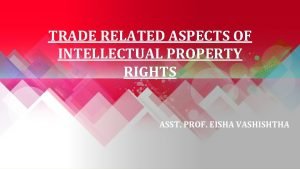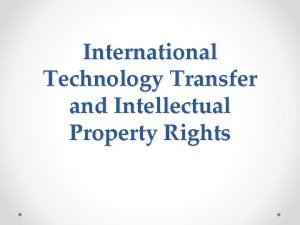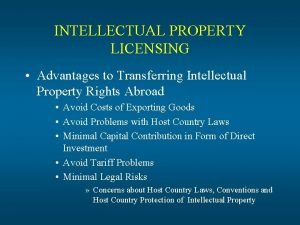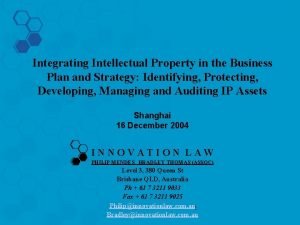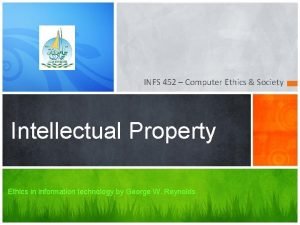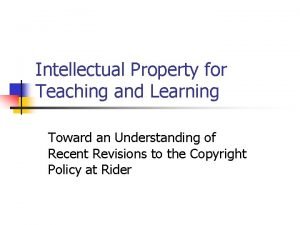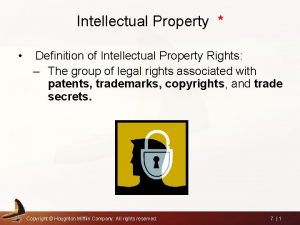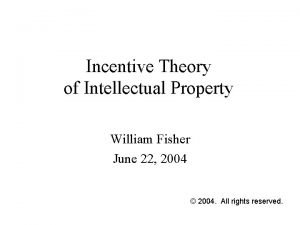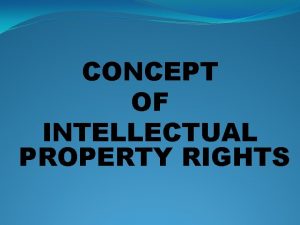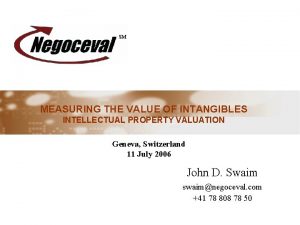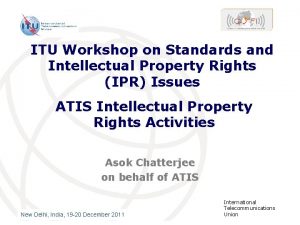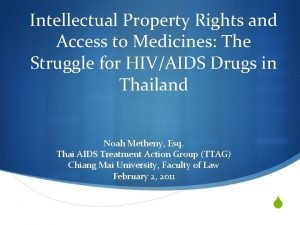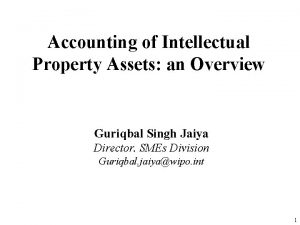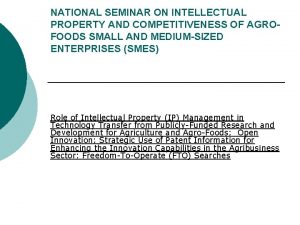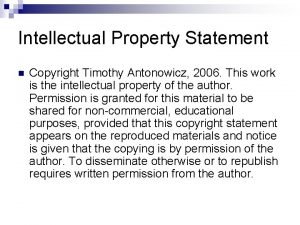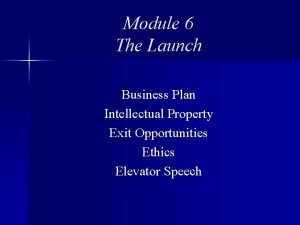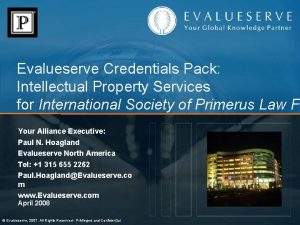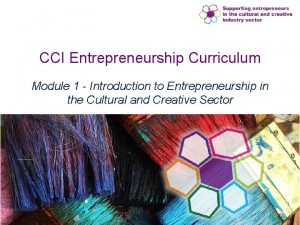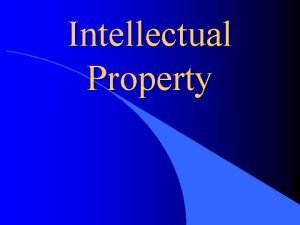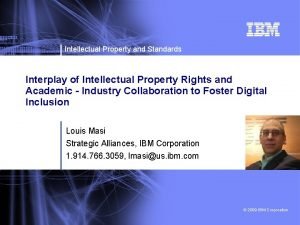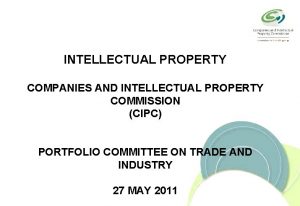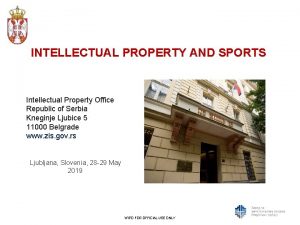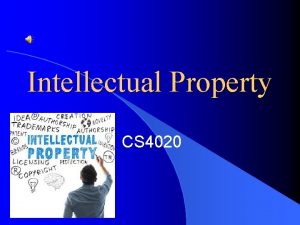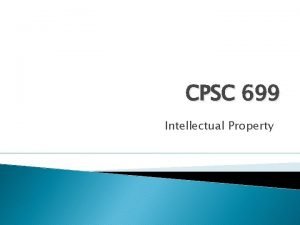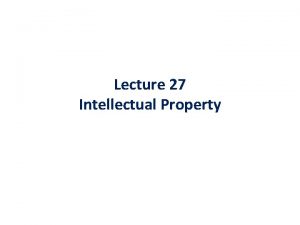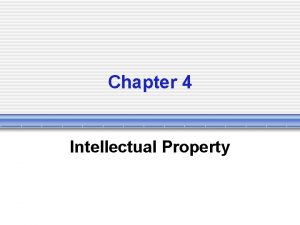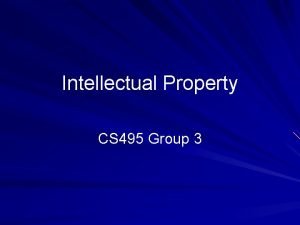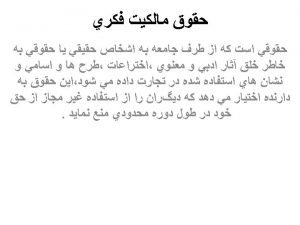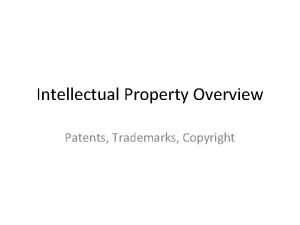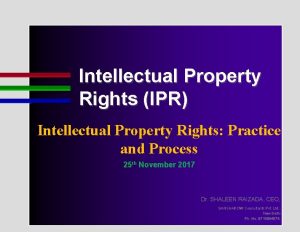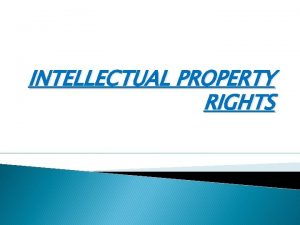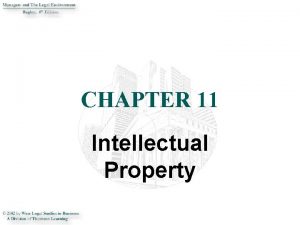Intellectual Property IP and Entrepreneurship Lectures In Entrepreneurship

































- Slides: 33

Intellectual Property (IP) and Entrepreneurship Lectures In Entrepreneurship

• • • What is a Intellectual Property (IP)? Copyrights Trademarks Patents The Patent Pilot Program (PPP)

What is IP? • “Intellectual Property” is a generic category for several rights created by statute including: – Copyrights – Trademarks – Patents • Note: there a number of other IP rights – Trade Dress – Trade Secret – Maskworks, etc.

What is IP? Typically a right to exclude or prevent someone from doing something. • Typically involves government registration • Typically a civil right – you go to court to enforce • Each of the three main rights are directed to something different – Copyright – how it looks or sounds (expression) – Trademarks – who sold it – Patent – how it works (functionality) •

What Is A Copyright? Exclusive right to a work of expression, such as a written story, a painting, or a song. • The subject of the copyright must NOT be functional – if it’s functional, look to patents • Lasts for a LONG time – life +70 of 95 years is common • Copyrights provide exclusive rights with regard to appearance or expression, but may be curtailed in certain situations such as fair use or parody, for example. •

How Do I Get A Copyright? Copyright “subsumes” in the work at the moment of the work’s creation – you make it, you have a copyright. • Register your copyright with copyright office • If unregistered, must prove damages • If registered, then higher statutory damages • – RIAA - $0. 23/song vs. $5000 per song • Mark your work to provide notice – © 2009 Joe Barich OR Copyright 2009 Joe Barich

What Is A Trademark? • • • A mark that identifies the origin of goods or services in trade Protect consumer from counterfeit products Can last forever – as long as you use it Standard for infringement is “consumer confusion”– if a consumer would think that goods from a second company actually originated from the company owning the trademark, then there may be infringement. Same mark may be used in different fields without confusion

How Do I Get A Trademark? Start selling goods with a mark on them. • Common Law Trademark Rights – arise when you sell your first products • – limited geographic scope – must prove damages – may not be able to expand • Use of “Pizza. TM” – provides notice that you are claiming Pizza as a trademark, but you may not be legally entitled to it. No examination – sue.

How Do I Get A Trademark? • Register your trademark with the Patent and Trademark Office (PTO) – Mark is examined – Mark is published for opposition • Federally Registered Trademark ® – Geographic scope of the entire US – Statutory Damages – May become incontestable • Mark your product to provide notice – Only registered products can use ®

What is a Patent? • Legal right to exclude others from practicing your invention – Not a right to use or make – Not a right to sell Does not guarantee that you are not infringing other patents • A sword, not a shield - does not “protect”, except as deterrent • In the Constitution itself – Art 1, Sec. 8, Clause 8 •

What Is A Patent? Functionality - How something works. Not expression – see Copyright • Lasts for 20 years from its date of priority (typically its date of filing). • But! takes 3 -5 years to issue as a patent right thus providing an enforceable term of approximately 15 -17 years. •

What Is A Patent? Copyright – rights at creation, registration increases rights • Trademark – rights at first use, registration increases rights • Patent – no rights at creation. Patent rights must be applied for at the Patent and Trademark Office (PTO) and issued by PTO. •

How Do I Get A Patent? • Draft patent application and submit to PTO – Patent application is a long technical document – Best to seek legal assistance • Patent application includes: – Specification describing the invention – Claims – what you can exclude others from doing. – Claims are the only legal right you can use to sue • PTO rejects your claims and you negotiate, argue, and amend

How Do I Get A Patent • To get a patent, claims must recite: 1) statutory subject matter that is 2) novel and 3) nonobvious. – Statutory subject matter - fit within the statutory classes of patentable subject matter. – Novel - no one single piece of prior art teaches all of the limitations in your claim. – Non-obvious - seven PTO tests based on prior art. • Note: Claims may be narrower than you suspectmay be possible to “design around”

Patent Terminology Note Filing =“Patent Pending” • Someone who has filed a patent application with the PTO is said to be “prosecuting a patent” and the process is often called “patent prosecution. ” • No rights to enforce patent until issuance • “Patent Pending” has even less of a right than “TM” •

Warning! - BAR DATES! U. S. has One Year Grace Period from date of first disclosure/commercialization – file or lose it • Foreign = No Grace Period – disclose/commercialize before filing and you blew it • Foreign rights can be preserved by filing an application in the U. S. before disclosure and then later filing foreign app claiming priority to U. S. app • Disclosures in confidence (to attorney, under agreement of confidentiality), without commercialization, are typically OK •

Computer Software May be able to obtain both copyright and patent for computer software • Software written on paper is considered a nonfunctional literary work, therefore copyrightable • Software executing on a computer is considered functional. If it is statutory subject matter, novel and non-obvious, it may be patentable. •

Copyrights vs. Patents • • • Copyrights must be expressive, patents are functional Copyrights last a lot longer (life +70 vs. 20 years) The alleged infringing article typically has to be a lot “closer” in the case of a copyright. Patent is viewed as a “stronger” right Copyrights are not examined Copyrights exist when the work is created

Trademarks vs. Patents • • • Trademarks designate the origin of goods patents are functional Trademarks can last forever Trademarks are infringed by consumer confusion – for patents, the claims must be infringed Both registered trademarks and patents are examined Trademark rights exist when the first product is sold – increased rights at registration

Copyrights vs. Trademarks • • • Trademarks designate the origin of goods – copyrights are expressive works Trademarks can last forever – ©=life +70 Trademarks are infringed by consumer confusion – for copyrights, copy, perform, many others Both registered trademarks and copyrights are registered, but only trademarks are examined Both give some rights without registration

How Entrepreneurs Use IP • Financially - IP is often the primary asset of a start-up company – Most of the value of the company is in their IP – Can boost corporate valuation –better price Bank loan security interest • Use as leverage for a joint venture or tech swap •

How Entrepreneurs Use IP IP is really a way to legally distort market power to your advantage • Without patents, large companies steal the small company’s idea and drive them out of business • With IP, the small company repays its shareholders and funds future development • Even if you are legally right, the dispute may not make business sense • – Vendors to large retailer – Small infringements – Undercapitalized small company suing large company

How Entrepreneurs Use IP • IP is often used as part of a negotiation rather than as a rigidly enforced right per se – Company A thinks they have a 50% chance of winning a patent litigation case against company B. Of course, taking the case to trial will cost $10 MM to each side. So they approach Company B aggressively, but it’s really a negotiation. The threat of the patent right is being used as a lever in the background to see what kind of concessions they can get from A. • 98% of cases are settled – the goal of business is to make money, not enforce abstract rights

How Entrepreneurs Use IP • • • Some real life examples just to make you think: Allegation of patent and trade secret infringement in order to get better shelf space to display product Allegation of patent infringement to obtain cobranding when target has well-known brand Allegation of patent infringement when you know competitor might be sold to a larger company and you don’t want them getting more capital Foreign manufacturer steals and patents Company’s IP and then threatens company with suit if they move any of their work to a new manufacturer

How Entrepreneurs Use Copyrights Creative businesses – music, graphic arts • Programming – probably couple with patents • Low barrier to entry for competitors– independent development providing same function is OK • Registered over 400 copyrights, usually in the context of recording assets for a security agreement or pre-litigation •

• • • How Entrepreneurs Use Trademarks Engineers fail to appreciate the power of branding and marketing Leverage a known brand to help gain market acceptance Make a recognizable brand defend it Corporate goodwill is a huge asset Search trademarks before adopting, but be prepared for an issue

How Entrepreneurs Use Patents • Patents can be truly powerful – Can provide for exclusive use of a function – May give you an exclusive market – Strong barrier to entry – Most valuable IP – strongest lever • Can be expensive to obtain and defend • Compare with trade secret which can give competitive advantage, but no barrier

Ownership of IP Can Be Tricky Practice tip – lots of mistakes here in practice • Understand when IP is created and lock it up immediately – if not before • – – Vendor and supplier IP agreements Employee contracts Joint venture provisions Open Source concerns Document creation and ownership of work • When in doubt, document again •

What’s the Patent Pilot Program (PPP)? TEC/College of Law Joint Effort • Draft a patent application for selected Cozad/Lemelson participants for free (typical cost 10 K-12 K) • Participants file themselves (we show how) and pay their own PTO fee •

Who Writes The Patent Applications? Law students in their 3 L (final) year • Have taken Patent Law and Patent Prosecution and earned a B+ or better (tough professor – Me!) • Most have law firm experience • Will be expected to draft patent applications professionally in the fall, typically without additional instruction •

Who will be supervising the law students? • • • Joe Barich Adjunct Professor, Co. L, 6 th year teaching About 11 years experience at a large patent specialty law firm, now a Shareholder Involved in the prosecution of more than 800 patents in the US and abroad 2008 and 2009 Illinois Rising Star on the Super Lawyers list

How Does the PPP Work? PPP works with inventor to draft patent application • Inventor must be available and help out • PPP Drafts patent application • – Law students draft – Prof. Barich reviews Inventor gets rights clearance from OTM and files patent application • Look for our start-up presentation in the spring •

Thanks! Questions?
 Trade related aspects of intellectual property rights
Trade related aspects of intellectual property rights Intellectual property rights in professional practices
Intellectual property rights in professional practices Importance of intellectual property
Importance of intellectual property Intellectual property management definition
Intellectual property management definition Advantages of intellectual property
Advantages of intellectual property Intellectual property business plan
Intellectual property business plan Intellectual property in computer ethics
Intellectual property in computer ethics Right to intellectual property of teachers
Right to intellectual property of teachers Industrial property definition
Industrial property definition Theories of intellectual property william fisher
Theories of intellectual property william fisher Concept of intellectual property
Concept of intellectual property Valuing intangible assets
Valuing intangible assets Intellectual property rights
Intellectual property rights Intellectual property rights
Intellectual property rights Characteristics of intellectual property
Characteristics of intellectual property Discuss intellectual property frankly
Discuss intellectual property frankly Sfas 142
Sfas 142 Intellectual property
Intellectual property Intellectual property statement
Intellectual property statement Intellectual property business plan example
Intellectual property business plan example Evalueserve patent search
Evalueserve patent search Discuss intellectual property frankly
Discuss intellectual property frankly At&t ecommerce
At&t ecommerce Classification of property law
Classification of property law Chemical property of water
Chemical property of water Introduction to entrepreneurship module
Introduction to entrepreneurship module Utilities and energy lectures
Utilities and energy lectures What is text linguistics
What is text linguistics Cell and molecular biology lectures
Cell and molecular biology lectures Commutative vs associative
Commutative vs associative Rick trebino lectures
Rick trebino lectures Lectures paediatrics
Lectures paediatrics Data mining lectures
Data mining lectures Medicinal chemistry lectures
Medicinal chemistry lectures
